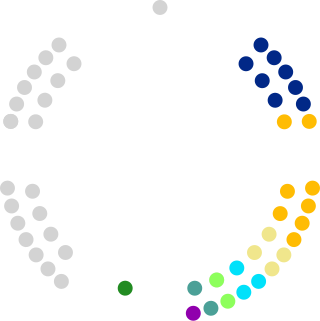Related Research Articles
The Solomon Islands Labour Party is a political party in Solomon Islands. The party was founded in 1988 by the Solomon Islands Council of Trade Unions after the leadership of the union split. Joses Tuhanuku, went on to lead the Labour Party, while Bartholomew Ulufa'alu formed the Solomon Islands Liberal Party.
Solomon Sunaone Mamaloni was a Solomon Islands politician. He was the first Chief Minister of the islands, and later served as Prime Minister for three spells in the 1980s and 1990s.

General elections were held in Fiji between 26 September and 8 October 1966, the last before independence in 1970 and the first held under universal suffrage. The result was a victory for the Alliance Party, which won 23 of the 34 elected seats. Its leader Kamisese Mara became the country's first Chief Minister the following year.


The National Parliament of Solomon Islands has 50 members, elected for a four-year term in 50 single-seat constituencies.
Changi Single Member Constituency was a single member constituency covering Changi and eastern outer islands such as Pulau Ubin, Singapore.

General elections were held in the Solomon Islands between mid-May and mid-June 1967.

General elections were held in the Solomon Islands between 22 May and 12 June 1973. The following year, Solomon Mamaloni of the People's Progressive Party became the first Chief Minister.

General elections were held in the Solomon Islands for the first time on 7 April 1965.
ꞌAreꞌare was a single-member constituency of the Governing Council and Legislative Assembly of the Solomon Islands. Created in 1973 when the Governing Council was expanded from 17 to 24 seats, it was located on the island of Malaita. In the 1973 elections the seat was won by David Kausimae, who had been elected in the South Central Malaita constituency in the 1970 elections, defeating Peter Kenilorea. It was abolished in 1976 and succeeded by East ꞌAreꞌare and West ꞌAreꞌare.

The Governing Council (GovCo) was the legislature and executive of the Solomon Islands between 1970 and 1974.
Central Malaita was a single-member constituency of the Legislative Council, Governing Council, Legislative Assembly and National Parliament of Solomon Islands between 1967 and 1993. It was abolished when Parliament was increased in size from 38 to 47 seats. Its final MP, Francis Joseph Saemala, was re-elected in the Aoke/Langalanga constituency in the 1993 general elections.
Central Solomons was a single-member constituency of the Legislative Council of the Solomon Islands. It was created in 1967 and abolished in 1970 when the Governing Council was created. Its sole elected member, John Plant Hoka stood for re-election in the Ngella/Savo/Russells constituency in the 1970 elections.

The Legislative Council (LegCo) was the legislature of the Solomon Islands between 1960 and 1970.
John Plant Hoka was a Solomon Islands politician.
East Isabel/Savo was a single-member constituency of the Governing Council and Legislative Assembly of the Solomon Islands between 1973 and 1976. Covering eastern Santa Isabel Island and Savo Island, it replaced the Ngella/Savo/Russells and Santa Isabel constituencies, and was succeeded by East Isabel and Russells/Savo.

Francis Aqorau Talasasa was a Solomon Islands civil servant and politician. He briefly served as a member of the Legislative Assembly in 1976.

The Hong Kong Island East geographical constituency is one of the ten geographical constituencies in the elections for the Legislative Council of Hong Kong which elects two members of the Legislative Council using the single non-transferable vote (SNTV) system. The constituency covers Eastern District and Wan Chai District on Hong Kong Island.

Hong Kong Island was divided into one or more constituencies of the Legislative Council following the first-ever election in 1985.
References
- ↑ Solomon Islands Election Passport
- ↑ Decolonising the Solomon Islands: British theory and Melanesian practice Archived 2016-03-05 at the Wayback Machine Alfred Deakin Research Institute